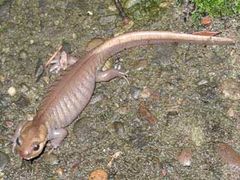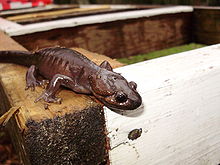- Northwestern Salamander
-
Northwestern Salamander 
Conservation status Scientific classification Kingdom: Animalia Phylum: Chordata Class: Lissamphibia Order: Caudata Family: Ambystomatidae Genus: Ambystoma Species: A. gracile Binomial name Ambystoma gracile
(Baird, 1859)The Northwestern Salamander (Ambystoma gracile) inhabits the northwest Pacific coast of North America. These fairly large salamanders grow to 8.7 in (220 mm) in length. It is found from southeastern Alaska on May Island, through Washington and Oregon south to the mouth of the Gulala River, Sonoma County, California. It occurs from sea level to timberline, but not east of the Cascade Divide. Its range includes Vancouver Island in British Columbia and Cypress, Whidbey, Bainbridge, and Vashon Islands in Washington (Snyder 1963).
Contents
Occurrence
The spotted forms occur in the northern portion of A. gracile's range (Petranka 1998; Snyder 1963). A dividing line of 51 degrees north latitude has been recognized between the two subspecies, with A. g. decorticatum occurring north of the line and A. g. gracile living to the south (Snyder 1963).
Populations with neotenic adults are widespread; the frequency of gilled adults increases with altitude such that adults at low and intermediate altitudes are almost all terrestrial, while adults at very high elevations are mostly neotenic (Eagleson 1976). An example of a paedomorphic population of the Northwestern Salamander occurs at Crater Lake, Oregon, which population is syntopic with Taricha granulosa.[2]
Terrestrial adults live in mesic habitats ranging from grasslands to mesophytic forests. Terrestrial adults are mostly fossorial, and are usually active on the surface only during fall rains and spring migrations to their aquatic breeding sites. However, they can sometimes be found under logs and other surface debris outside of the breeding season (Petranka 1998; Efford and Mathias 1969).
Conservation
The status of Ambystoma gracile populations is unknown (Blaustein et al. 1994). No declines are apparent in Canada (Weller and Green 1997). In the Cascade Mountains of Washington, Aubry and Hall (1991) found A. gracile to be far less abundant in young forests than in old-growth forests. However, Corn and Bury (1991) surveyed Western Oregon and found little correlation between salamander abundance and stand age, so it remains unclear whether A. gracile requires old growth forest to thrive. Clear-cutting, however, seems to render the habitat unsuitable; Corn and Bury found no salamanders on recent clear-cuts. Petranka (1998) suggests leaving a forest buffer of 200-250 m surrounding breeding sites used by terrestrial adults to preserve optimal environmental conditions for local populations.
Sources
- Hammerson (2004). Ambystoma gracile. 2006. IUCN Red List of Threatened Species. IUCN 2006. www.iucnredlist.org. Retrieved on 12 May, 2006. Database entry includes a range map
- C. Michael Hogan (2008) Rough-skinned Newt (Taricha granulosa), Globaltwitcher, ed. Nicklas Stromberg
Line notes
Categories:- IUCN Red List least concern species
- Mole salamanders
- Least concern species
Wikimedia Foundation. 2010.


